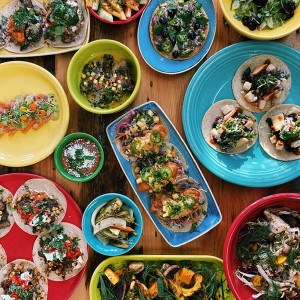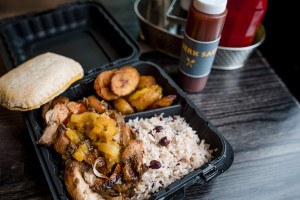Spanish Ayes

Photo by Heath Robbins
We tried to get the pig’s head. We really did. Where else can you get a whole roasted pig’s head for $45? Or for any price? With orange sauce, if you please?
Alas, it was not to be. By the time our table mustered the guts to say, Okay, let’s do it, we’d already ordered a slew of tapas at Estragon. We did try substituting the pig’s head for the far less daring 16-ounce cowboy-cut rib-eye we’d chosen. But our request came too late. Out came the steak, and our porcine fix would have to wait for another visit.
Still, the steak was remarkable—”as tender as filet mignon, with the flavor of sirloin,” the steak lover among us remarked. It had the marbling and much of the softness of Kobe beef, and superior flavor, for a better price ($33), compared with many big chunks of premium meat at other restaurants. No tricks: salt, olive oil, a grill, not even much char. Just really good meat (it’s from Savenor’s), plus some equally succulent grilled figs. We went through the whole dish before we could properly mourn the pig’s head.
I wasn’t expecting a plain steak to be so good. In fact, I wasn’t expecting steak, period. This, after all, is Boston’s first ambitious Spanish restaurant since Ken Oringer opened Toro, on Washington Street in the South End, and the news out of Spain—world capital of new-wave experimentation—hardly centers on simple grilled steak.
Located on Harrison Avenue (the new Washington Street, the new boulevard of restaurants), Estragon is aiming for the Boston big leagues. It’s part of a Spanish complex that’s long overdue: not just a bar/restaurant with lots of street seating, which is welcome enough, but also an adjoining Spanish gourmet shop called Las Ventas.
Co-owner Julio de Haro also ran (with his former wife, Deborah) Brookline’s Taberna de Haro, long the insider’s pick for like-in-Madrid food. Estragon, which de Haro has opened with partner Lara Gavigan, aims higher than Taberna. Most of the menu, though, is still more traditional than experimental, with plenty of meat and not much by way of vegetables, and there’s an overall old-school polish that bold Barcelona would likely find old hat (the way Barcelona views all of Madrid), but here feels pretty persuasive.
The interior aims for 1930s debonair, though the gold floral wallpaper and severe black décor with silver curlicued lighting fixtures look more 1960s Miami Beach to me than 1930s Madrid. The walls and ceiling, with scarcely a piece of sound-absorbing upholstery to be seen, reverberate mercilessly. The tables at Estragon are well spaced, but there’s an appealing long central bar where singles and couples can hang out and order a bite, and as a result the room is loud to the point of needing to yell to your dinner partner when the restaurant is only half full.
Noise and salt and occasional unevenness are the sole flaws in this excitingly ambitious new restaurant. Only the first two should make you hesitate, though just for a moment. If you want Spain-style Spanish, you’ll get it from chef Alex Castagneto (formerly of B & G, Great Bay, and Lineage): oil-sautéed Marcona almonds ($4); a properly oily, soft-potato-filled tortilla ($4); sautéed chunks of homemade Basque sausage ($6), fresh and crumbly and porky (they’d be even better on a grill), with only a faint pepper kick; ham, either a plate of the jamón blanco with Spanish honey and Marcona almonds ($7) or one luxurious serving of the newly available (in the United States) jamón ibérico ($20), marvelously marbled and sliced in irregular shards, as per custom. And something you should find made this well at every Spanish bar: croquetas ($10), a minor miracle of frying, crisp egg-and-crumb-battered torpedoes enclosing still-runny béchamel sauce and smoky ham nuggets. They’re irresistible, at once thirst-making and hunger-sating. Nothing is more Spanish than one of these plates with a glass of sherry, and Estragon might have the city’s best selection—one that will make you rethink any image you might have of sickly-sweet sips for tippling aunts.
The real interest of Estragon is the dishes you won’t get anywhere else. Take the tongue on toast ($6). No, really, try it: The tongue is cooked from scratch, sliced thin, and buried in a slightly hot mojo verde—what the menu calls a “Canary Island salsa”—with avocado, bell peppers, garlic, and lots of parsley and sherry vinegar. You won’t know it’s tongue, just something soft and, yes, palatable. Nor will you know that the golden mini disks painted with a creamy mayonnaise are actually cod cheeks with pil pil ($6), not mayo at all but a sauce of the fish’s natural gelatin emulsified with olive oil. You’ll just think they’re what snack-sized fish fillets ought to be. Veal sweetbreads ($12) might be a tougher sell, because they’re undisguised, though pretty: one foie gras–like slab, dusted in flour and expertly sautéed so it’s soft and fresh-tasting in the center, its natural sweetness accented by “toasted milk sauce,” a slightly caramelized, pudding-thick concoction dancing a delicate balance between sweet and savory, and accented by wedges of grilled orange. This is sophisticated cooking, incorporating techniques we haven’t seen before.
Not up for anything quite that exotic? Leave the offal to the gastronauts and stick with the classic tapas—or the superior “feisty” fries ($8), with a sweet and hot paprika dipping sauce, notable for good frying technique using plenty of the olive oil the kitchen employs in everything. That’s a benefit of the traditional emphasis; a drawback is the salting, heavy even by Madrid standards and especially pronounced in plain fish dishes, such as the grilled whole bronzino ($26) and the cod fillet with chili oil ($26). That latter unremarkable offering at least has something most main courses—in fact most dishes—at Estragon don’t have: vegetables, in this case slices of zucchini. Shoestring fries are a more typical side. For greens or vegetables, you need to order one of the salads or the roasted eggplant ($6), which is awfully good but oily, too, and covered with little chunks of chorizo and pine nuts.
You won’t have room for dessert, but the three offered are all worth ordering: flan ($6), of course, served room-temperature as a low, wide disk with enough runny caramel to make a light soup; an odd and slightly tough but interesting chickpea-flour pound cake ($8), served with classic natilla (custard) sauce and grilled peaches; and three custom ice creams from Toscanini’s ($7), developed at Estragon’s request. Two of the ice creams, nougat and salty caramel (the third is sherry), deserve to always have a place on the menu.
Okay, I’d like less noise and less salt. But both of those are pretty Spanish. So are the friendly service and lively street scene that help Estragon bring brassy, vivid urban life to a part of the city that didn’t even know it needed it.
700 Harrison Ave., Boston, 617-266-0443


